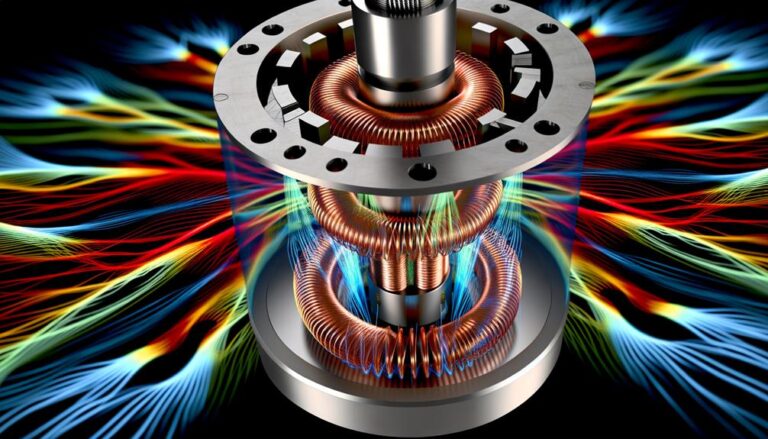What Drives the Magnetic Power: Scientific Principles?
What drives the magnetic power? Let’s explore the fascinating scientific principles behind it.
Did you know that the Earth itself acts as a giant magnet, with a magnetic field that extends into space? This magnetic force is governed by scientific principles such as magnetic fields, flux lines, and magnetic flux density.
These principles allow us to understand and harness the power of magnetism in our everyday lives. By studying magnetic fields and their properties, we can uncover the secrets of how magnets work and how they interact with other objects.
Join us on this journey as we delve into the captivating world of magnetism and discover the scientific principles that drive its power.
Magnetic Field Generation
Generating a magnetic field involves creating a current flow in a conductor. This flow of electric current creates a magnetic field around the conductor.
The principles of magnetism state that a magnetic field is produced whenever there’s a moving electric charge. In the case of generating a magnetic field, the electric current flowing through the conductor serves as the moving charge.
The strength of the magnetic field depends on the magnitude of the electric current and the distance from the conductor. The Earth’s magnetic field, which has north and south poles, is also generated by electric currents.
Understanding the process of magnetic field generation is crucial in various applications, such as electromagnets and electric motors, where the manipulation of magnetic fields is essential for their operation.
Electromagnetic Induction
To understand the process of electromagnetic induction, we need to delve into the principles that drive the generation of electric currents through changing magnetic fields.
When a magnetic field, such as one produced by a magnet with a North and South pole, interacts with a conductor, it can induce an electric current in that conductor. This occurs due to the magnetic force exerted on the charged particles within the conductor.
The Earth’s magnetic field can also play a role in electromagnetic induction. When a coil of wire is moved within the Earth’s magnetic field, a current is induced in the wire.
This phenomenon, known as electromagnetic induction, is the foundation for the operation of generators and is crucial in various practical applications such as power generation, transformers, and electric motors.
Magnetic Domains and Alignment
One key aspect of magnetic power lies in the alignment of magnetic domains within a material, which determines its overall magnetic properties.
Magnetic domains are regions within the material where atomic magnets align in the same direction. When a material is magnetized, these domains align themselves with the applied magnetic field. Each domain acts like a tiny magnet with a north and south pole. The alignment of these magnetic poles is what creates a magnetic field.
External magnetic fields can influence the alignment of the domains, causing them to reorient. Temperature also plays a role, as increased heat can disrupt the alignment.
Understanding the alignment of magnetic domains is crucial for the development of permanent magnets and other magnetic materials.
Paramagnetism and Diamagnetism
Studying the behavior of paramagnetism and diamagnetism allows us to understand the magnetic properties of materials and their response to external magnetic fields.
Paramagnetism occurs in materials that contain unpaired electrons, which align with an external magnetic field, producing a magnetic field of their own. This alignment results in a net magnetic moment and makes the material attracted to a magnet.
On the other hand, diamagnetism occurs in materials with all paired electrons. When exposed to an external magnetic field, these materials create small magnetic fields that oppose the applied field. This opposition causes the material to be repelled or weakly attracted to the magnet.
Both paramagnetism and diamagnetism are fundamental phenomena that arise from the movement of charged particles and contribute to our understanding of magnetism.
Magnetic Hysteresis
In understanding the magnetic properties of materials, we continue our exploration into the subtopic of Magnetic Hysteresis, delving into its scientific principles. Magnetic hysteresis refers to the phenomenon where a material retains some magnetization even after the magnetic field that magnetized it has been removed. This behavior can be observed in ferromagnetic materials, such as iron or nickel.
Here are five key points to consider:
- Magnetic hysteresis occurs due to the alignment of magnetic domains within the material.
- The hysteresis loop represents the relationship between the applied magnetic field and the resulting magnetization.
- Scientists use hysteresis loops to study the magnetic properties of materials and design magnetic devices.
- The process of magnetizing and demagnetizing a material can be achieved through the application of an electrical current or by using a bar magnet.
- Understanding magnetic hysteresis is crucial for optimizing the performance of magnetic systems and devices.
Conclusion
So, what drives the magnetic power? Scientific principles such as magnetic fields, flux lines, and magnetic flux density. These principles help us understand how magnetic fields are generated, how electromagnetic induction works, and how magnetic domains and alignment play a role.
We also explored the concepts of paramagnetism and diamagnetism, as well as magnetic hysteresis. By understanding these principles, we can better monitor and control magnetism levels in machinery and prevent potential failures.
Fascinating, isn’t it?






